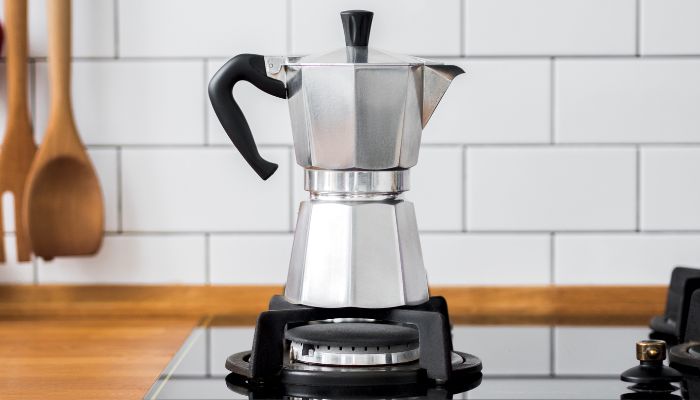Percolated coffee is a classic coffee brew that’s been around for a very long time. It’s a bit more hands-on than other kinds of brews, but the end result is a strong and bold cup. Since you’re going to be hands on, what’s the verdict on how long to percolate coffee?
How long to percolate (perk) coffee?
The optimum time to let coffee percolate is about 5 minutes. If you prefer a stronger cup, you can push this to 8 minutes or anything in between, but if you go above 8 minutes, you’ll end up with a cup that’s just too bitter to enjoy.
Keep in mind that you’ll have to pay close attention to the percolating coffee to make sure the temperature does not get too high.
You don’t want to end up boiling the water!
How to make the best percolator coffee
Step 1: Measure and heat the water
Measure the exact amount of water you need for the number of coffee cups you want. You have no control over limiting the water once the process starts.
If you have a small percolator, you’ll only be able to brew a single cup anyway.
Bring the water to a boil in a kettle and fill the bottom chamber with water up to the valve.
Step 2: Grind your coffee
If you’re wondering what fineness of ground coffee you need, go for a medium grind like the kind you’d use for drip coffee.
Step 3: Add coffee grounds to the percolator
Next, place the filter on top of the bottom chamber and add your coffee grounds. One tablespoon (roughly 8-10 grams) of coffee grounds should be enough for a nice single cup, but you can adjust the amount up and down to your personal preference.
Use a spoon to level the coffee but don’t tamp it like you would an espresso.
Step 4: Assemble the percolator
Screw on the upper chamber(use a towel to grip the bottom chamber to avoid getting burned) and place the percolator on a hot stove.
The idea is that as the water heats up and begins to evaporate, it will percolate through the coffee grounds and be forced through the small tube in the top chamber.
Step 5: Wait
Continue maintaining low heat to keep the temperature stable and let the entirety of the water evaporate and percolate into the top chamber.
Step 6: Pour out
Once the water has fully brewed into coffee, you’re done. You’ll be able to tell when the sputtering and bubbling subsides.
Remove from the stove, but be careful – the handle can get a little hot too. Pour into a cup and enjoy.
How to use an old fashioned coffee percolator
Percolation is the older cousin of espresso and Aeropress in that it uses pressure to make brewed coffee.
Old fashioned percolators are kind of hands-on because you need to manually heat the water and monitor the percolator on the stove.
It’s important to preheat the water because the water has to be hot enough before it starts percolating in order to brew properly.
If you don’t preheat the water, the water will start evaporating before it gets hot enough, resulting in a very weak cup of coffee.
Electric percolators, on the other hand, are much easier to use. They’re more set and forget than stovetop percolators.
For good electric perk coffee, you just need to be using fresh beans, ground to the correct consistency, and you’ll end up with an awesome cup of coffee every time.
Most electric percolators have sensors built in that ensure the temperature does not rise beyond a certain point.
Why you want to drink perked coffee
Perked coffee is a classical way to make coffee. It’s how they used to do it in the olden days, and it’s no surprise that this way to make coffee has lasted so long.
Percolator coffee is one of the easiest ways to brew coffee when you are camping. Camping coffee makers are small and you can easily place them on a camping stove.
In fact, a friend of mine prefers a percolator for all of her travel coffee needs, not just for camping. It’s small enough to throw into a suitcase and just take it everywhere.
No matter where you go, you should have access to a stove or a heat source, so you’ll never be short of coffee with a stovetop coffee maker.
Additionally, a coffee percolator is usually made of metal and can last a lifetime if you take care of it properly. Some other coffee brewing methods generate some kind of waste(like paper filters from drip coffee, or worse, the pods from single serve coffee makers).
Percolators generate no waste aside from the coffee grounds, which are actually really good as fertilizer, among other things.
Disadvantages of percolator coffee
I think the main reasons percolator coffee has gone out of fashion except amongst a select few is that it’s more hands on than other brewing methods.
Additionally, no matter the kind of coffee grounds you use, percolator coffee will always be much bolder and more bitter than say drip or french press coffee, which is usually a much more mellow brew.
Still, there’s definitely a time and place for this cup of coffee, and for a true coffee connoisseur, there is no shortage of the kinds of brewing methods they use!
For example, my go-to coffee is an espresso or a lungo, but that does not mean I don’t enjoy an occasional french press, aeropress, or a cold brew!
Conclusion: How to get good percolator coffee every time
The keys to making good percolated coffee every time are quite simple:
- Clean your coffee pot every time. A dirty pot results in a murky brew.
- Use freshly ground coffee beans, from freshly roasted beans. This holds true for good coffee no matter what kind of brewing process you are using.
- Try to use filtered water. The more minerals there are in your water, the more unwanted flavors will end up in your coffee
How do you know when percolator coffee is done?
You’ll know percolator coffee is done when you hear a sputtering sound. The sputtering indicates that most of the water has been brewed.
Do coffee percolators make good coffee?
Percolator coffee is similar to espresso and Aeropress in its intensity. It’s usually very bold and full-bodied.
What kind of coffee do you use in a percolator?
The best kind of coffee to use in a percolator is a medium or dark roast. These flavors will be enhanced the most by the percolator brew.






